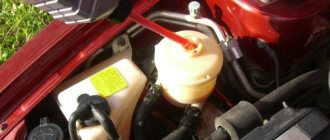Power steering (hydraulic power steering) is an automotive system that makes driving easier and increases traffic safety. In order to understand how to change the oil in the power steering, you need to have an idea of the principle of its operation.
From the hydraulic barrel, under the action of a pump driven by the crankshaft through a belt, the liquid is directed by a distributor into the hydraulic cylinder. Thanks to the pressure created by the supplied fluid, the movements of the steering rack and the turning of the wheels are facilitated.
Why is it necessary to change the power steering oil?
To increase the service life of the steering mechanism and power steering elements, periodic updating or complete replacement of the fluid is recommended. Intensive use, climatic conditions, and malfunctions in the system have an impact on the properties of the oil.
- wear of the steering rack seals. Failure to detect the problem promptly results in loss of oil level. Operating the pump at an insufficient level can cause the lubricant to burn.
- Air leaks in places where lines are attached to system elements and the formation of cracks in the tank cause oil foaming. The steering wheel may become wedged during sharp turns. It is recommended to eliminate the cause and replace the fluid.
- natural aging of a liquid under the influence of physical and chemical processes. Steering rack wear products (metal shavings) get into the lubricant. Change in composition due to large temperature changes.
- work that requires draining the power steering fluid. Repair of steering rack, power steering pump.
- frequent use of the vehicle. The recommended maximum mileage occurs faster than the expiration date of the lubricant.
The most common malfunctions of the power steering pump and its design - video
Accompanying signs of a system malfunction is a hum when the steering wheel is rotated. In winter, it may appear when starting a cold car, and disappear as it warms up. Difficulties in rotation, dips and a wedge in the steering wheel may also indicate that the power steering fluid is not fulfilling its duties.
If it is necessary to restore the lubricant level or when replacing, it is necessary to take into account the recommendations and requirements set by the manufacturer for special equipment. liquids. According to functionality and properties, for ease of identification, all liquids are divided into three types: green, red, yellow.
Difference between types of power steering fluid by color
Which, in turn, can be mineral or synthetic based. Mixing red and yellow oils on the same basis is allowed. Green liquid is not compatible with the others.
Important! The interaction of mineral and synthetic lubricants can lead to sedimentation, reduce the throughput of the filter element in the tank, reduce pressure in the system, reduce the lubricating properties of the fluid and affect the performance of the power steering steering system as a whole.
Green power steering fluid.
This mixture is used exclusively for hydraulic power steering systems and is not suitable for automatic transmissions. The green composition can be either synthetic or mineral oil.
The most common question is choosing between mineral and synthetic composition. If the manufacturer's instructions do not specifically indicate synthetic oil, then it is best to use a mineral composition. The fact is that there are many rubber components in the hydraulic booster system. Synthetics adversely affect the performance of rubber components and accelerate their wear. In order to use synthetics in servicing the hydraulic booster system, it is necessary to make sure that the rubber components of the aggregate react normally to synthetics and have a special composition.
Power steering device
When servicing the power steering, it is necessary to take into account some rules in order not to reduce the service life of the system.
- Mixing yellow and red mineral-type liquids is allowed.
- Green liquids cannot be mixed with other compounds.
- Synthetic and mineral oils are not allowed to be mixed.
How many liters will be required
The amount of oil used in the power steering differs for different cars. Exact information can be found in the technical documentation for vehicle maintenance.
The regulated replacement periods are also indicated there. Some manufacturers do not specify the frequency of power steering oil changes. The lubricant is designed for the entire period of operation.
It is still recommended to replace it at least 100,000 km. Or once every 3-4 years. Carry out diagnostics periodically and, if necessary, change them unscheduled.
Depending on the replacement method, you may need from 1 to 2 liters of fluid for an average passenger car. You can find out how to choose the right power steering oil by reading this article.
Tips for operation and maintenance.
1. Before starting to service the hydraulic booster system, carefully read its features specified in the manufacturer’s instructions.
2. Promptly perform system maintenance and replace waste fluid within the time limits specified by the manufacturers.
3. Do not mix incompatible types of oil in the system. Regularly check the tightness of the working fluid conductors.
https://youtube.com/watch?v=hjWxGNB69e8%3F
When replacing the working mixture, use power steering fluid from trusted manufacturers. The use of high-quality compounds will increase the service life of the system. Thus, you will avoid large-scale breakdowns and vehicle maintenance costs.
If the slightest malfunction occurs, promptly diagnose the system and stop further use. If you use a damaged power steering system, you may also incur unwanted car repair costs.
Happy servicing!
How to change oil in power steering
There are several ways to change power steering oil - partial and complete. Let's consider both options.
Partial replacement
You will need: new power steering fluid, a syringe with an extension (a piece of hose of suitable diameter), a drain container.
- Open the power steering reservoir cap. Using a syringe, pump out the existing liquid into the prepared container.
Pumping out the liquid from the tankA graduated or transparent container will make it possible to understand the amount of lubricant. New power steering fluid is poured in the same quantity or according to the min/max marks on the dipstick (on the filler cap) or reservoir.
- We start the car and turn the steering wheel alternately to the left and right extreme positions. At least three repetitions.
- We turn off the car.
- We repeat the entire procedure as many times as possible until the power steering fluid changes its color to one close to the color of fresh lubricant.
Up to two liters of new oil may be needed.
Several options for complete replacement
You will need: fresh power steering oil, a syringe, a container for working out, and pliers.
- We pump out the old fluid from the tank. Remove the clamps from the tank fittings.
- Disconnect the supply and return hoses. We act carefully, the fittings are fragile.
- We dismantle the power steering reservoir. Wash with a cleaning agent (carburetor cleaner, brake cleaner, etc.).
- Blow with compressed air or let dry.
Blow out the tank with compressed air
On some cars, a filter or filter mesh is installed in the power steering reservoir. Could be a magnet. If the power steering tank is serviceable, change the filter or mesh. When the design allows, it is enough to get by with washing.
If replacing the filter is not possible, it makes sense to replace the tank assembly. Otherwise, the new power steering oil will lose some of its properties when passing through a dirty filter.
A clogged filter or mesh loses its capacity. Due to lack of pressure, the power steering system may fail, which cannot but be another argument in favor of replacement.
Complete exhaustion and system purging
- Place the return hose in the drain container. For convenience, it can be extended using an adapter-fitting.
- We hang the front axle of the car. With the car turned off, turn the steering wheel all the way, first in one direction, then in the other. The movements should be quite intense. We are watching how the mining is drained. Rotate the steering wheel until the oil stops pouring out.
- Next, disconnect the ignition coils. We turn the starter for 5-10 seconds, while simultaneously turning the steering wheel to its extreme positions. If you have a compressor and a blow gun, we clean the system with compressed air through the lubricant supply hose.
- We install a clean or new power steering container in its regular place. We connect the fluid supply and return hoses. Fill in new oil.
Fill in new fluid, in our case yellowWe turn the steering wheel and monitor the level of lubricant in the reservoir. We add it in a timely manner, preventing the container from completely emptying and airing the system. After the level has stopped decreasing, we continue to rotate the steering wheel until air stops leaving the system (bubbles on the surface of the oil in the tank).
- We connect the ignition coils and start the car. Keeping an eye on the level, we pump the system. Rotate the steering wheel without holding it in extreme positions for more than one second. We bring the level to a position between min and max.
note
This method allows you to achieve maximum renewal of the power steering fluid, but if the system is poorly pumped, the remaining air can affect the operation of the pump and the system as a whole.
Substitution method
- We install a clean or new hydraulic booster reservoir in its normal place.
- We connect the oil supply hose leading to the pump. We clamp it with a clamp.
- The tank fitting for the return line must be plugged (rubber cap, a piece of hose closed with a bolt on the reverse side). We lengthen the return line. We use a transparent hose to be able to control the renewal of the fluid.
use a transparent PVC hose - Fill in new lubricant above the normal level.
- With the car turned off, turn the steering wheel from the extreme right to the extreme left and vice versa. We repeat the steps until new oil flows through the transparent hose.
- We disconnect the additional hose, remove the plug from the tank fitting and put the return line in its place, clamping it with a clamp. Since the power steering tank contains oil, you need to act quickly to avoid large lubricant leaks.
- We start the car and bleed the system. We monitor the level and escaping air in the tank.
Controlling the liquid level
Without further ado, changing the power steering oil step by step - video
The need to replace the power steering fluid is obvious, even in the absence of manufacturer's recommendations. The serviceability of the steering directly affects traffic safety. The replacement can be done either independently or by seeking help from specialized service stations.
How to change power steering fluid photo and video
The power steering, like other components and assemblies of the vehicle, requires periodic maintenance. Now you will learn how to replace power steering fluid with your own hands and which fluid is best to use for this. You can find out more here: https://rvsmaster.ru/catalogue/_gidrousilitel_rulya.
Changing power steering oil
If you smell a burning smell in the cabin and realize that it is the smell of power steering oil, then you need to start replacing consumables as soon as possible.
What to prepare?
Changing power steering consumables consists of several stages. First of all, this is preparation, as well as the replacement process itself.
- New grease for power steering. This consumable must be purchased strictly according to the recommendations of the vehicle manufacturer. Therefore, carefully read the service book and find out how to choose power steering oil for your car.
- Syringe with hose. It will be required to pump out used lubricant from the system.
- Containers for waste substances. A regular plastic bottle with a capacity of 1-2 liters will do.
- Preventive additive RVS Master Power Steering Treatment Ps2. By adding it regularly to the system, you can restore the linear dimensions of its elements to optimal, as well as reduce gaps. In addition, as practice shows, you can reduce the level of extraneous noise that occurs during long-term operation of the car without replacing consumables in the power steering.
There are several ways: full shift or partial. Let's look at each separately.
Partial replacement
The method of partially changing consumables is easier, but it is also less effective. To partially change the oil, follow these steps:
- Open the cap of the expansion tank into which you need to fill the power steering oil.
- Take the prepared syringe with a hose and lower it as far as possible with the end of the pipe.
- Start the process of pumping out the waste substance. You must completely pump out the oil from the expansion tank. After this, take new fluid and pour it until it reaches the MAX mark.
- Then start the car and turn the steering wheel in all directions until it stops. Turn off the engine.
- Open the expansion tank cap again and check the fluid level in it. Add it if necessary.
- Pour a bottle of RVS Master Power Steering Treatment Ps2 into the tank at the rate of 60 grams per 2 liters of oil. Add another bottle after 4-5 thousand kilometers.
Complete replacement
If you still decide to do everything efficiently and completely change the oil in the power steering, then this method is for you. It is more labor-intensive, but this way you can achieve complete pumping of waste material.
- Place the front of the car on a jack so that the wheels are hanging in the air. It is necessary that you can safely turn the steering wheel in all directions without starting the engine.
- Unscrew the tank cap and pump out all the consumables from it with a syringe.
- Then, using a wrench, disconnect the pipes that go to the power steering fluid reservoir. If necessary, rinse and dry it.
- The pipe that goes from the steering rack to the tank must be placed with the free end into the bottle, since lubricant will flow out from there. To provoke it to exit the system, sit behind the wheel and turn it several times in all directions.
- When the substance from the system is completely drained, you will need to insert a funnel into the second pipe, which goes to the power steering pump.
- Pour new lubricant into it while turning the steering wheel. This is where you may need some extra hands.
- It is necessary to top up the lubricant until new liquid begins to come out of the pipe located in the bottle. When this happens, you can rest assured that the lubricant has been completely removed from the system.
- Reinstall all pipes and tank. Add enough liquid to it so that it stops at the MAX mark.
- Start the engine and turn the steering wheel in both directions. If necessary, add more consumables.
- Now take a bottle of RVS Master Power Steering Treatment Ps2 and also add it to the expansion tank. Please note: one bottle with a capacity of 60 grams is enough for 2 liters of substance for power steering. From time to time, add fluid to the system to increase the service life of the consumables, as well as for the purpose of preventing the power steering system.
https://youtube.com/watch?v=LjpaInjh5zc











